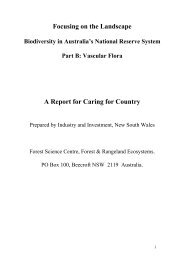Biodiversity in Australia's National Reserve System - Part ... - BushBlitz
Biodiversity in Australia's National Reserve System - Part ... - BushBlitz
Biodiversity in Australia's National Reserve System - Part ... - BushBlitz
Create successful ePaper yourself
Turn your PDF publications into a flip-book with our unique Google optimized e-Paper software.
Huntsman Spiders (Sparassidae)<br />
The ANHAT database has 1162 records for 116 species and subspecies of huntsman spiders.<br />
Eleven of these species account for approximately 50% of the total species records <strong>in</strong><br />
ANHAT. Each of these species had over 20 records <strong>in</strong> the ANHAT database.<br />
Table 66 Sparassidae species that account for approximately 50% of the total species<br />
records <strong>in</strong> ANHAT.<br />
Species No. Records<br />
% total<br />
records<br />
Isopeda villosa 24 2.07<br />
Isopeda magna 24 2.07<br />
Holconia fl<strong>in</strong>dersi 25 2.15<br />
Neosparassus diana 27 2.32<br />
Isopedella saundersi 34 2.93<br />
Isopedella <strong>in</strong>ola 36 3.10<br />
Holconia nigrigularis 45 3.87<br />
Isopedella cerussata 68 5.85<br />
Isopeda leishmanni 82 7.06<br />
Isopedella leai 107 9.21<br />
Delena cancerides 119 10.24<br />
Total 591 50.87<br />
The majority of species of huntsman spiders present <strong>in</strong> the ANHAT database have been<br />
rarely recorded, with 86 of the 116 species be<strong>in</strong>g represented by 10 or fewer <strong>in</strong>dividual<br />
record sites (Table 67). Aga<strong>in</strong>, such a large number of species leaves little opportunity to<br />
recognise trends <strong>in</strong> the database, especially as the habitat types of the majority are not easily<br />
identified. The very few records for most species leave it essentially impossible to state<br />
clearly what their habitat preferences are, even if there is any published <strong>in</strong>formation available<br />
to provide an <strong>in</strong>dication. The limited <strong>in</strong>formation does not even allow broad regional<br />
distributions, with only state list<strong>in</strong>gs generally be<strong>in</strong>g available. This means that <strong>in</strong> most<br />
<strong>in</strong>stances the distribution of a species is very difficult to assess with any confidence.<br />
However, some species with location data occur <strong>in</strong> more than one state, and the majority of<br />
species occur <strong>in</strong> eastern Australia. The lack of records for clearly often widespread species<br />
reflects the general lack of collect<strong>in</strong>g and identification of the <strong>in</strong>vertebrates with<strong>in</strong> Australia.<br />
As is common for the <strong>in</strong>vertebrates <strong>in</strong> general, no huntsman spider species have been<br />
assessed for list<strong>in</strong>g under the EPBC Act.<br />
149






